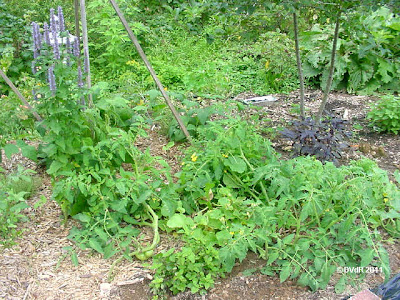 |
| Photo taken 6/4/11 |
 |
| Photo taken 7/23/11 |
In June I posted about starting an apple guild
here. Now that it's already August, there are already noticeable improvements to the area, but there are still years needed to grow to maturity and sustainability.
Some of my friends were kind enough to give me a few herb plants for the apple guild project while I was attending a garden swap in June: lemon mint, peppermint (I already had spearmint), bee balm, chives and garlic chives, marjoram, oregano and 2 annual basil plants (a spicy globe basil, and a purple basil). I bought thyme and dill starts for the guild, and also transplanted some anise hyssop, yarrow and lemon balm from another garden bed.
All the herbs will attract pollinators, and some are also nutrient accumulators (yarrow, chives, lemon balm).
 |
| 6/4/11 |
So far I have dug up the weeds in a small area about 6' x 10' on 1 side of the apple tree (it's hard work even without record heat), and planted 2 teepees with haricot verts (French skinny green beans) to fix some nitrogen in there. Since the apple is still small, I put a couple of tomato plants and the basil at the edge of the current drip line where they will not rob nutrients from the apple roots.
I wish I knew how large the apple will eventually grow, but I've lost contact with the man who gave it to me. I may have to enlarge the outer ring of bulb protectors (hopefully to be planted this fall) as the tree matures since they should be planted at the (currently unknown) mature drip line.
About 6 feet into the weeds to the right of the apple are 3 rhubarb plants, which will stay. Behind the bean teepees are 4 currant bushes (2 black and 2 red); they will also stay. They look pretty pitiful (struggling) after 4 years here.
I started some annual nasturtiums to help attract pollinators (both dwarf bush type and vining) plus some flowering sweet peas to put in there somewhere, too. The sweet peas grew about 4" and then died; I think it was too warm, and too late in the season for them. The nasturtiums are struggling, but I think it's just the heat.

A long bed against the front of my house had some strawberries lost in the jungle and struggling for light. I dug them out, cut them back, and put them in a tray of potting soil mixed with sand to sprout. They will go around the apple tree as a shallow-rooted edible ground cover.
 |
| Photo July 23 |
Here are the strawberries (at least the few that survived) around the base of the tree, photo taken July 23. They have rooted nicely, and will spread. Herbs to the right and left of the tree trunk have grown considerably from the transplant stage and I have harvested some already. The purple (left) is an annual basil with a small spicy globe basil in front of it, the plant on the right is the perennial anise hyssop.
 |
| Growing More Lush, photo taken 8/17/11 |
There is much work to be done building this guild over the next couple of years, but I am quite pleased with the progress so far. Hopefully by this fall I will get a few comfrey plants transplanted around the guild. I have put lots of cut comfrey
leaves on the ground as a mulch in there... they disappear into the clay quickly!
I was tardy in getting a second planting of green beans mixed in among the first round, but they still have time to fruit before frost. Even if they don't produce many beans, they will add some nitrogen to the soil.
This entire planting area was just lawn grass that I covered with weed cloth and mulch about 4 years ago. Each year I added more mulch and it has broken down, so that when I finally (and laboriously) removed the underlying weed cloth this year I had some 'almost soil' to leave on top.
Unfortunately the area under the cloth is still hard packed clay, but if I allow the deep rooted dandelions to grow in there next year (and maybe plant daikon?) which bring up deep minerals from the subsoil... and add mulch, eventually it will attract worms that churn and break up some of the clay. I'll also add some
greensand this fall as it helps break up the clay plus it will add micronutrients to help
remineralization.
I have a huge pile of aged willow chips (almost inaccessible) down in the gulch near the spring house, left from last year's tree work... and if I can ever get some help, I'll mulch the guild area heavily this fall. The other woodchip pile the tree guys left near the street is more easily accessible, but it contains a lot of black walnut which would kill most things in the guild.
This is one of my more interesting projects in this garden, and one that will take the longest time. Others have been straw bale gardening, and this year's random vegetable planting.



























